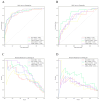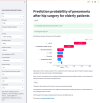Incorporating preoperative frailty to assist in early prediction of postoperative pneumonia in elderly patients with hip fractures: an externally validated online interpretable machine learning model
- PMID: 38816811
- PMCID: PMC11137973
- DOI: 10.1186/s12877-024-05050-w
Incorporating preoperative frailty to assist in early prediction of postoperative pneumonia in elderly patients with hip fractures: an externally validated online interpretable machine learning model
Abstract
Background: This study aims to implement a validated prediction model and application medium for postoperative pneumonia (POP) in elderly patients with hip fractures in order to facilitate individualized intervention by clinicians.
Methods: Employing clinical data from elderly patients with hip fractures, we derived and externally validated machine learning models for predicting POP. Model derivation utilized a registry from Nanjing First Hospital, and external validation was performed using data from patients at the Fourth Affiliated Hospital of Nanjing Medical University. The derivation cohort was divided into the training set and the testing set. The least absolute shrinkage and selection operator (LASSO) and multivariable logistic regression were used for feature screening. We compared the performance of models to select the optimized model and introduced SHapley Additive exPlanations (SHAP) to interpret the model.
Results: The derivation and validation cohorts comprised 498 and 124 patients, with 14.3% and 10.5% POP rates, respectively. Among these models, Categorical boosting (Catboost) demonstrated superior discrimination ability. AUROC was 0.895 (95%CI: 0.841-0.949) and 0.835 (95%CI: 0.740-0.930) on the training and testing sets, respectively. At external validation, the AUROC amounted to 0.894 (95% CI: 0.821-0.966). The SHAP method showed that CRP, the modified five-item frailty index (mFI-5), and ASA body status were among the top three important predicators of POP.
Conclusion: Our model's good early prediction ability, combined with the implementation of a network risk calculator based on the Catboost model, was anticipated to effectively distinguish high-risk POP groups, facilitating timely intervention.
Keywords: Catboost; Orthopedic surgery; Postoperative pneumonia; Prediction model; Risk factor; mFI-5.
© 2024. The Author(s).
Conflict of interest statement
The authors declare no competing interests.
Figures






Similar articles
-
Machine Learning-Based Prediction of Postoperative Pneumonia Among Super-Aged Patients With Hip Fracture.Clin Interv Aging. 2025 Feb 27;20:217-230. doi: 10.2147/CIA.S507138. eCollection 2025. Clin Interv Aging. 2025. PMID: 40034472 Free PMC article.
-
Development and Validation of an Explainable Machine Learning Model for Predicting Myocardial Injury After Noncardiac Surgery in Two Centers in China: Retrospective Study.JMIR Aging. 2024 Jul 26;7:e54872. doi: 10.2196/54872. JMIR Aging. 2024. PMID: 39087583 Free PMC article.
-
Frailty is associated with an increased risk of postoperative pneumonia in elderly patients following surgical treatment for lower-extremity fractures: A cross-sectional study.Medicine (Baltimore). 2023 Apr 14;102(15):e33557. doi: 10.1097/MD.0000000000033557. Medicine (Baltimore). 2023. PMID: 37058022 Free PMC article.
-
Interpretable machine learning model to predict surgical difficulty in laparoscopic resection for rectal cancer.Front Oncol. 2024 Feb 6;14:1337219. doi: 10.3389/fonc.2024.1337219. eCollection 2024. Front Oncol. 2024. PMID: 38380369 Free PMC article. Review.
-
Examination of factors causing postoperative pneumonia in elderly hip fracture patients: A narrative review.Medicine (Baltimore). 2025 Feb 28;104(9):e41700. doi: 10.1097/MD.0000000000041700. Medicine (Baltimore). 2025. PMID: 40020120 Free PMC article. Review.
Cited by
-
A Comparison of Machine Learning-Based Models and a Simple Clinical Bedside Tool to Predict Morbidity and Mortality After Gastrointestinal Cancer Surgery in the Elderly.Bioengineering (Basel). 2025 May 19;12(5):544. doi: 10.3390/bioengineering12050544. Bioengineering (Basel). 2025. PMID: 40428163 Free PMC article.
-
Machine Learning-Based Prediction of Postoperative Pneumonia Among Super-Aged Patients With Hip Fracture.Clin Interv Aging. 2025 Feb 27;20:217-230. doi: 10.2147/CIA.S507138. eCollection 2025. Clin Interv Aging. 2025. PMID: 40034472 Free PMC article.
-
Machine learning and transformer models for prediction of postoperative pneumonia risk in patients with lower limb fractures.Sci Rep. 2025 Jul 1;15(1):22409. doi: 10.1038/s41598-025-04623-y. Sci Rep. 2025. PMID: 40595785 Free PMC article.
References
Publication types
MeSH terms
Grants and funding
LinkOut - more resources
Full Text Sources
Medical
Research Materials
Miscellaneous

